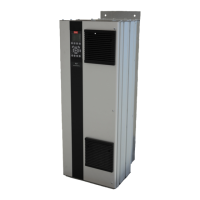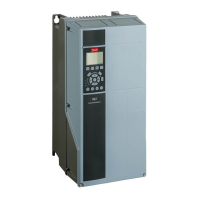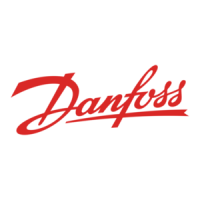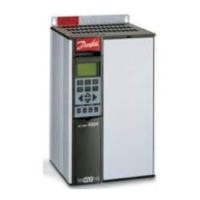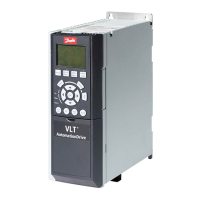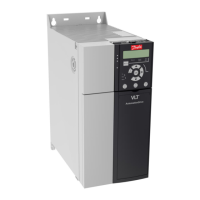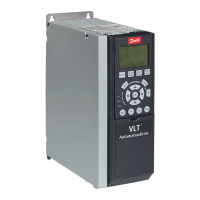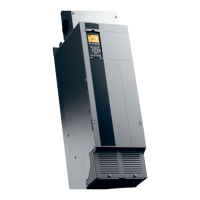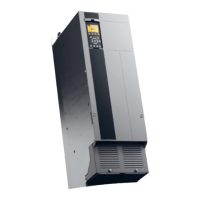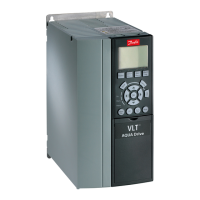

Do you have a question about the Danfoss VLT AQUA FC 202 and is the answer not in the manual?
Provides essential safety information and warnings for handling the unit.
Highlights critical safety precautions regarding electrical hazards and potential injuries.
Outlines necessary steps to take before performing maintenance or repair on the unit.
Explains procedures to prevent accidental motor startup during operation or parameter changes.
Describes the Safe Torque Off function and its wiring requirements for safety.
Guidance on selecting an optimal location considering ambient conditions and access.
Detailed steps for physically mounting the frequency converter.
Guidelines for ensuring adequate cooling and airflow for optimal performance.
Comprehensive guide to performing electrical connections and installations.
Instructions on how to correctly connect the main power supply cables.
Critical procedures for proper grounding to ensure safety and EMC compatibility.
Information on using residual current devices for enhanced protection.
Configuration details for the RFI switch to manage interference.
Proper torque specifications for tightening all electrical connections.
Requirements and methods for connecting shielded cables for EMC compliance.
Guidelines and specifications for connecting the motor cable correctly.
Steps for connecting the main power supply to the unit.
Recommendations for selecting and installing fuses for protection.
Information on installing and using main disconnectors for isolation.
Details on circuit breakers used in F enclosure types.
Guide to operating the Graphical Local Control Panel (GLCP) interface.
Guide to operating the Numeric Local Control Panel (NLCP) interface.
Procedures for modifying parameter values on the LCP.
Methods for initializing the frequency converter to factory default settings.
Introduction to the process of programming frequency converter parameters.
Using the Quick Menu for efficient parameter setup and configuration.
Optimizing parameter setup specifically for water application requirements.
Accessing and setting basic parameters for initial frequency converter operation.
Configuration options for application-specific functions.
Accessing and programming all available parameters via the main menu.
Guidance on navigating and selecting parameter groups and individual parameters.
Detailed explanations of frequently used parameters and their functions.
Detailed descriptions of parameters available within the Main Menu.
Configuration of fundamental operating modes and settings.
Setting the operating mode: Open Loop or Closed Loop.
Inputting the nominal motor power according to the nameplate data.
Inputting the nominal motor voltage according to the nameplate data.
Setting the motor frequency based on the nameplate data.
Inputting the nominal motor current for torque and thermal calculations.
Entering the nominal motor speed for automatic motor compensations.
Procedure for optimizing motor performance through automatic adaptation.
Defining the minimum obtainable reference value for the system.
Configuration of the closed-loop PID controller for output frequency control.
Overview of integrated protection features and operational safeguards.
Lists and explains all possible alarms and warnings with probable causes and remedies.
Diagnoses and remedies for low control card voltage conditions.
Diagnoses and remedies for live zero errors on analog input signals.
Troubleshooting steps when no motor is detected connected to the output.
Identifies issues related to missing mains phases or voltage imbalance.
Addresses conditions of high DC link voltage and potential unit behavior.
Addresses conditions of low DC link voltage and potential unit behavior.
Diagnoses and remedies for DC overvoltage conditions leading to trips.
Diagnoses and remedies for DC under voltage conditions causing trips.
Troubleshooting steps for inverter overload conditions and alarms.
Diagnoses motor overheating and thermal protection faults.
Troubleshooting issues related to motor thermistor over-temperature faults.
Addresses issues related to torque limit violations during operation.
Troubleshooting steps for overcurrent faults and trip conditions.
Diagnoses and remedies for earth faults in the output phases.
Troubleshooting steps for short circuits in motor or motor wiring.
Diagnosing faults related to a missing motor phase U.
Diagnosing faults related to a missing motor phase V.
Diagnosing faults related to a missing motor phase W.
Diagnosing faults related to mains supply failure or imbalance.
